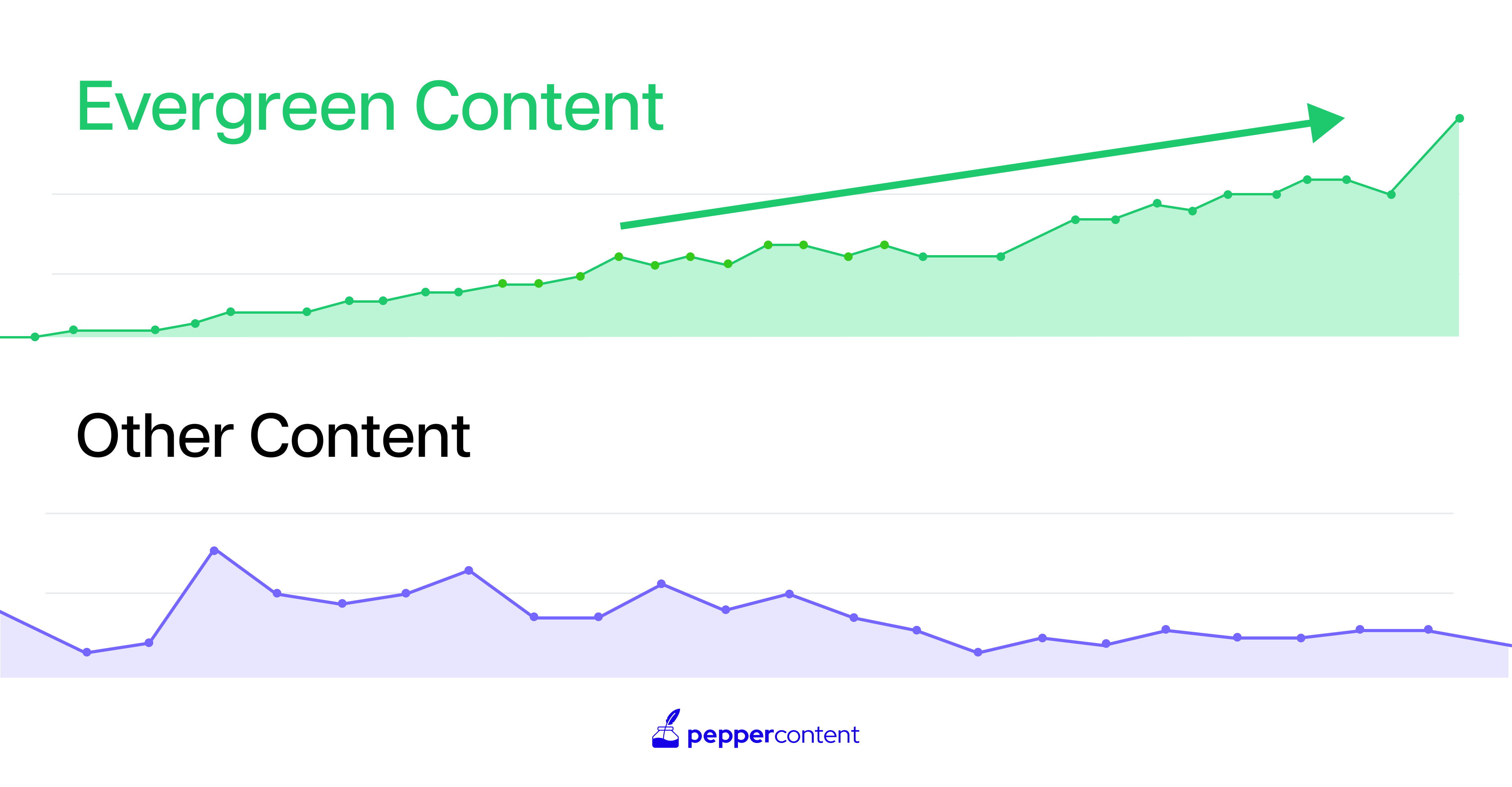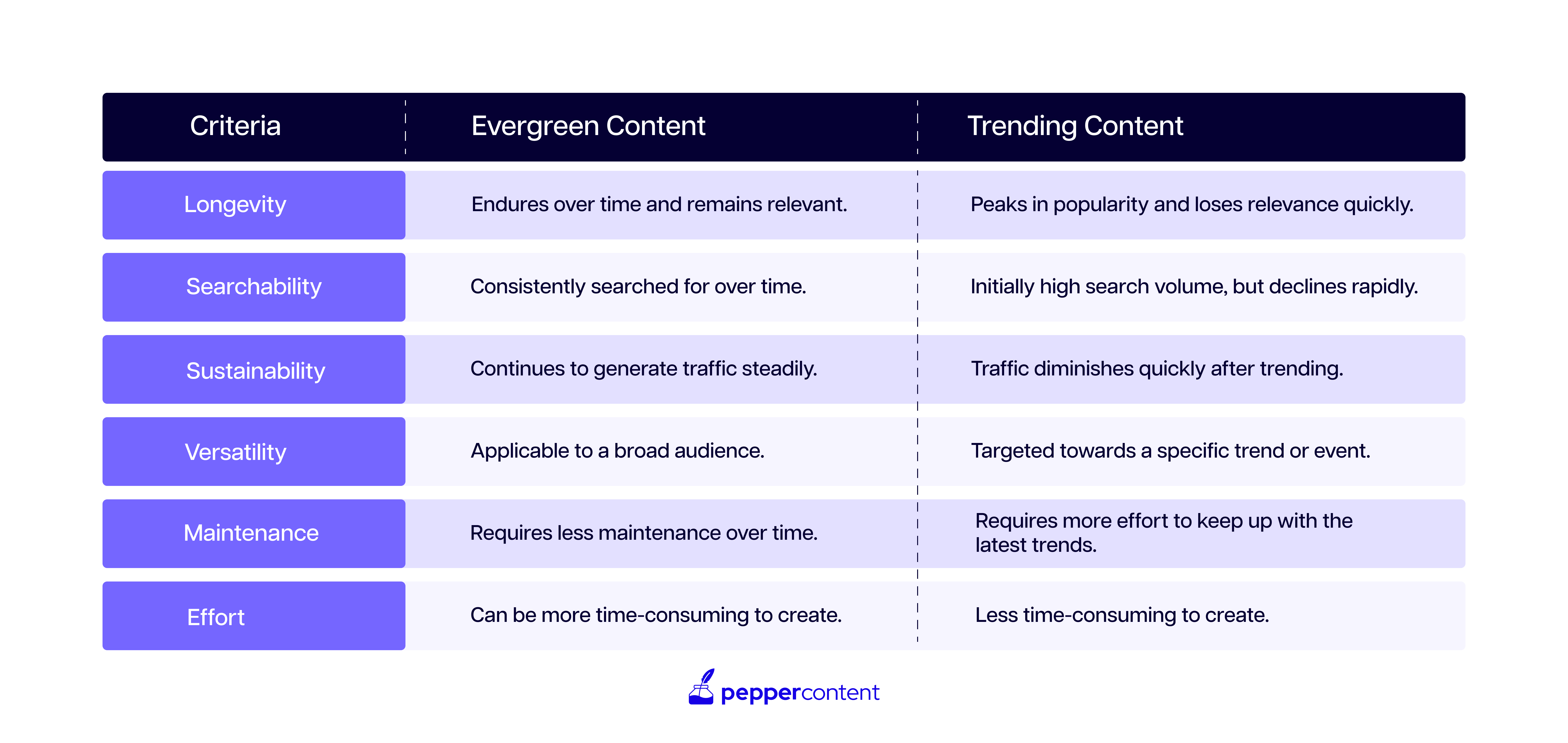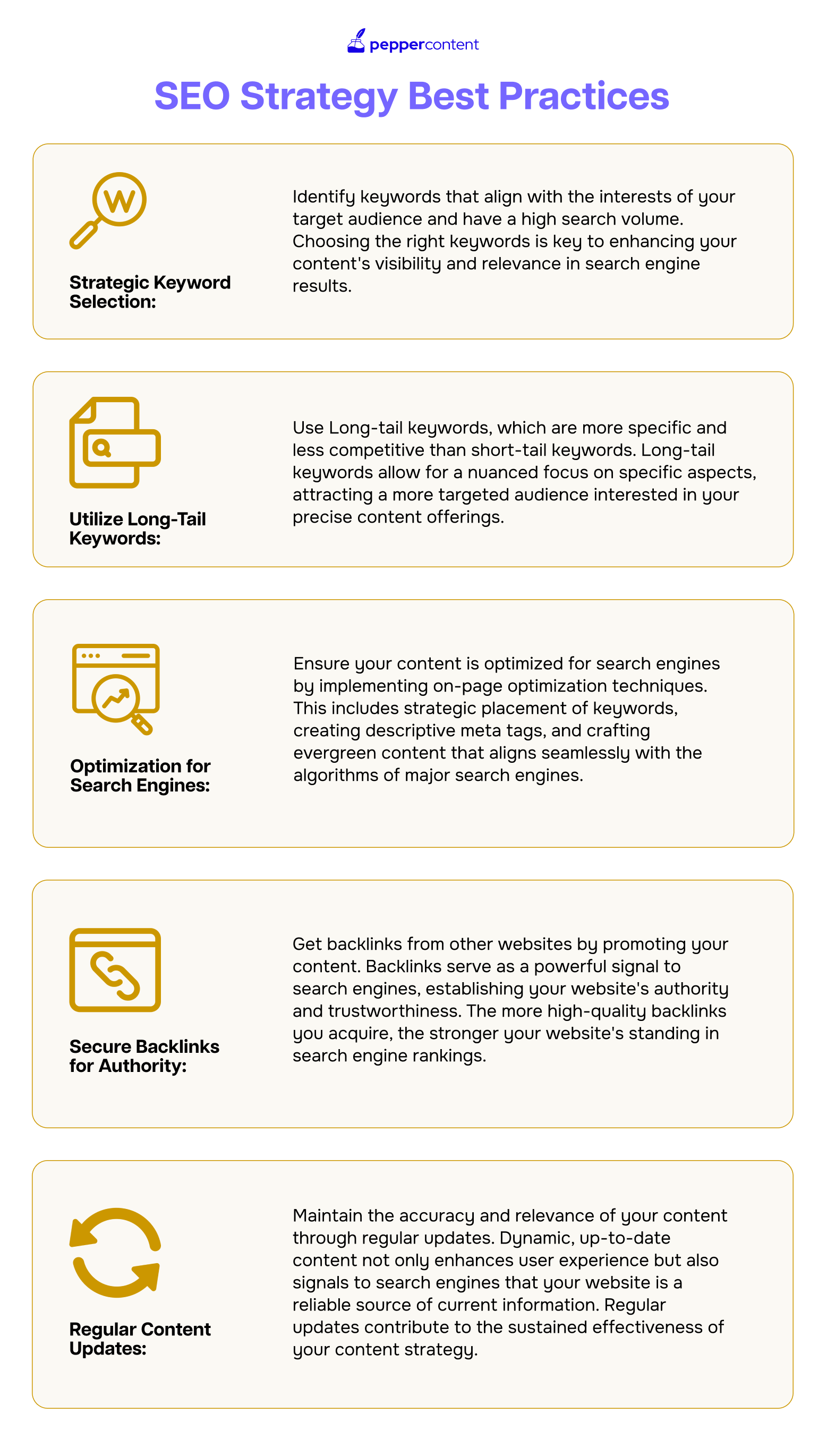The Evergreen Advantages of Content Marketing in Providing Long-Term Traffic

Many factors contribute to the success of content marketing, and one indispensable aspect is the inclusion of evergreen posts. Irrespective of your niche, integrating evergreen content ideas into your approach can be a powerful tool to enhance blog traffic and increase user engagement.
So, what is evergreen content? What are its distinct features? And how can you strategically incorporate various evergreen content into your marketing efforts? In this article, we’ll explore the advantages of evergreen content in the dynamic landscape of content marketing.
But first — let’s understand what evergreen content is.
Evergreen content is timeless, relevant, and valuable content that remains popular and useful over a long time. It is often high-quality, in-depth, and informative and is designed to answer common questions and solve user problems. BuzzSumo states that evergreen content is 3x more likely to be shared than non-evergreen content. A DemandGen report cited by HubSpot confirms that evergreen content generates 9x more leads than non-evergreen content.
Ty Heath, the Director of Market Engagement at LinkedIn’s B2B Institute, says:
“Most of your growth potential lies in reaching people who won’t buy from you today but who will buy from you in the future.“

One great example of evergreen content is Wikipedia, which invites contributions from individuals worldwide. This unique approach enables users to add, verify, and update information regularly, making content relevant for extended periods. This dynamic quality transforms the entire platform into a valuable repository of evergreen content, making it an invaluable resource for those interested in historical narratives.
While Wikipedia mainly focuses on evergreen content, it also has an “In the News” section. This specific segment caters to a readership looking for a mix of both evergreen and breaking content. By incorporating this feature, Wikipedia successfully caters to diverse preferences, maintaining a balance between evergreen and trendier, less-evergreen content.
Now that we understand what evergreen content is, let’s dive deeper into it!
Why Short-Term Traffic Boosts Are Not Sustainable
Short-term traffic boosts, often achieved through strategies like Pay-Per-Click (PPC) advertising and social media ads, may provide immediate spikes in website visits, but they often lack the sustainability and long-term benefits associated with content marketing.
Put simply, the majority of PPC campaigns come with a sell-by date. The nature of PPC lies in a brief, time-bound display of advertisements — you initiate the ad, it runs for a set period, and then it comes down, accompanied by a billing cycle. To illustrate, a study by WordStream found that the average click-through rate (CTR) for PPC ads is just 6%. A study by Hootsuite showed that the average organic reach for Facebook posts is only 5.2%. Similarly, Sprout Social found that the average engagement rate for Instagram posts is only 1.22%.
On the other hand, content marketing lasts forever. That is, your digital presence lasts indefinitely, contingent only upon the regular payment of domain and hosting fees. The content you generate on your websites and social media platforms remains accessible to your audience for years.
Moreover, the beauty of content marketing lies in its ability to serve as a continuous lead-generation mechanism. As long as your audience continues to view and interact with your content, you’re not just sustaining your online presence – you’re consistently generating new leads. This continuous generation of leads contrasts sharply with the finite and time-limited impact of PPC campaigns.
From a return on investment (ROI) perspective, content marketing exhibits virtually unlimited potential. As your audience discovers, shares, and engages with your content, the compounding effect on traffic generation can result in sustained and growing returns, making content marketing a strategic and enduring investment in the long-term success of your digital presence.
Conceptual Framework: The Evergreen Nature of Content
Evergreen content is typically SEO content that stays relevant and remains consistently “fresh” for its audience. The term “evergreen” resonates even beyond marketing circles, drawing a parallel with evergreen trees, often of the pine or fir variety, commonly used to decorate homes during Christmas. These trees, retaining their leaves year-round instead of shedding, symbolize relentless life. Similarly, evergreen content is known for its sustainability and lasting impact on the digital landscape.
You might wonder, “But isn’t all online content sustainable? Articles and blog posts don’t just vanish.” While this is true, the difference lies in the term “evergreen,” signaling content that continues to be relevant long past its publication. Below are some of the most popular types of evergreen content:
- How-Tos: Evergreen content often includes instructional materials that address timeless questions or problems. For instance, a “How to Start a Small Business” guide remains relevant over the years.
- FAQs (Frequently Asked Questions): FAQs provide enduring answers to common queries within a particular niche. A well-curated FAQ page can serve as a valuable resource for your audience.
- Industry Guides: Comprehensive guides that delve into industry-specific topics tend to remain relevant, offering ongoing value. For instance, an “Ultimate Guide to Digital Marketing” can stand the test of time.
Now, both trending and evergreen content types are essential for a company. Evergreen content can help businesses to build authority and expertise in their industry while trending content can help businesses to reach a wider audience and generate traffic in the short term. To compare:

The SEO Value of Evergreen Content
The longevity of evergreen content is instrumental in enhancing a website’s visibility, authority, and overall performance in search engine rankings. One of the core strengths of evergreen content lies in its strategic use of keywords. Unlike trending topics that may have a momentary surge in search volume, evergreen content targets keywords with consistent, long-term relevance. For instance, an article on “Effective Time Management Techniques” could incorporate keywords like “time management tips,” ensuring its relevance as users continuously seek such guidance.
Similarly, the more backlinks a piece of content gathers, the higher its domain authority becomes. Consider how reputable online publications link to in-depth research articles or informative guides. These backlinks contribute to the content’s credibility and boost its visibility in search engine rankings.
Real-World Examples of Evergreen Content Success
HubSpot
HubSpot, a leading provider of inbound marketing and sales software, has a massive library of evergreen content on its website, including blog posts, e-books, and webinars to showcase its expertise and generate leads.
One brilliant example is their webinar titled “The Science of Email Marketing.” This free, hour-long webinar imparts valuable insights and actionable tips for crafting successful email marketing campaigns. Hosted by HubSpot’s expert marketing team, it covers crucial topics like email list segmentation, best practices in email design, and implementing email automation.
The results garnered from HubSpot’s webinar are nothing short of impressive. Within a year, the HubSpot webinar generated over 20,000 leads and $250,000 in sales, boasting a conversion rate of 12%. Additionally, it has been viewed more than 75,000 times, earning a satisfaction rating of 94% from attendees.
HubSpot’s success with webinars can be attributed to several pivotal factors:
- They meticulously identified their target audience. Their webinar was designed to offer practical insights and strategies for leveraging LinkedIn Ads to generate leads.
- What sets HubSpot apart is its engaging and knowledgeable marketing team, capable of delivering insights and tips that are both accessible and easy to implement.
- They executed a comprehensive marketing strategy that included blog posts, social media ads, and email campaigns to ensure maximum reach and drive registrations.
IBM
IBM is a U.S.-based technology company that demonstrates a successful approach to creating evergreen content. They focus on providing valuable insights and practical guidance to overcome B2B marketing challenges. By sharing market trends and industry insights, they establish themselves as trustworthy thought leaders.
For instance, by offering detailed case studies or whitepapers on effective account-based marketing and leveraging data analytics for targeted campaigns, IBM’s content not only educates but also equips businesses with solutions they can implement. This strategy enhances brand credibility and positions IBM as an expert in the B2B marketing sphere.
Nike
Nike has masterfully leveraged evergreen content to create a lasting impact, continuing to reap benefits from copy written years ago. One striking example is the iconic “Just Do It” campaign, launched in 1988. The simple yet powerful slogan, accompanied by memorable visuals, has become a timeless representation of Nike’s brand identity.

The “Just Do It” campaign is a prime illustration of evergreen content. The phrase transcends the boundaries of a mere marketing tagline; it has evolved into a cultural mantra that resonates across generations. Whether applied to sports, fitness, or personal challenges, “Just Do It” encapsulates a universal message of determination and action.
Decades after its inception, Nike continues to integrate the “Just Do It” slogan into its marketing campaigns, product launches, and brand messaging. The enduring nature of this evergreen content allows Nike to consistently connect with consumers, tapping into the emotional and motivational aspects that the slogan represents.
Today, the campaign has over 15 million Instagram posts and even more across other social media networks. It is the primary evergreen way Nike generates user-generated content (UGC) around its brand.
How to Produce High-Quality Evergreen Content
Evergreen content is undoubtedly one of the best long-term investments in marketing your business. In fact, research suggests it’s three times more efficient than outbound marketing and costs 62% less.
But how do you go about producing high-quality content? Follow these broad tips to get started:
- Research and choose topics that people are always interested in, such as “how to lose weight,” “how to start a business,” or “how to write a blog post.”
- Write in-depth and informative content. Your content should be comprehensive and give readers everything they need to know about the topic.
- Use clear and concise language. Avoid jargon and technical terms that your readers may not understand.
It is not enough just to have a dashboard and calendar of content. Your content has to be relevant to an evolving audience and has to play a role in converting leads into customers. You must, therefore, have an SEO strategy that keeps your content at the top of SERPs and continues to generate relevant long-term traffic.

Now that you have worked out how to produce high-quality, evergreen content, actively promote your content to increase its discoverability. Employ a multi-channel approach, leveraging social media, email marketing, and other platforms to broaden the reach of your content.
Share on platforms like Twitter, LinkedIn, and Facebook. Next, submit your content to online directories and search engines. Google alone processes around 8 billion searches daily, so make sure your content is structured for your audience and its search behavior. At the same time, promote your content in emailers to reach your existing subscribers and promote your content to new potential readers.
Finally, don’t let your content stagnate. Repurpose it into different formats, such as infographics, videos, and e-books, to reach a wider audience and get more mileage.
How to Measure the Long-Term Impact
Once you’ve published your content online, seeing if your efforts are paying off is crucial. Are you seeing the results you were hoping to achieve? What’s working? Where can you improve?
These questions underscore the dynamic nature of your content strategy — a continuous, evolving component of your overall marketing plan. The mantra, “Measure, Analyze, and Adjust,” is the compass guiding the trajectory of success. This is why monitoring your metrics and key performance indicators (KPIs) to evaluate your efforts is necessary.
To facilitate continuous improvement, businesses can leverage many tools and platforms for tracking and analytics. These tools measure the performance of your content, analyze key metrics, and make informed adjustments to optimize your overall content marketing strategy.
- Google Analytics and SEMrush are robust platforms for tracking website metrics, including visitor demographics and behavior.
- Social media platforms like LinkedIn offer built-in analytics tools that deeply understand audience engagement, reach, and interactions.
- Email marketing platforms, such as Mailchimp, HubSpot, or Constant Contact, offer analytics features to measure the effectiveness of email campaigns.
Here are some of the key metrics to track:
- Website Traffic
- Lead Generation
- Social Media Engagement
- Conversion Rates
- Number of Sign-Ups
Remember, flexibility and responsiveness are key in navigating the ever-changing landscape of content marketing.
Conclusion
As we’ve explored the role of evergreen content in establishing domain authority and providing long-term traffic, it becomes evident that content marketing is not just any other marketing approach but a cornerstone for achieving visibility and engagement.
For businesses seeking to elevate their digital presence and secure long-lasting traffic, Pepper Content is your one-stop shop for all your evergreen content needs. Our team of expert content creators specializes in crafting timeless, impactful content that resonates with your audience over the long haul.
Reach out to us today for strategy and writing services that will drive your business value.
Latest Blogs
Learn how to rank on AI search engines like ChatGPT, Perplexity, and Gemini by optimizing your content for authority, structure, and relevance. Stay ahead in AI-driven search with this strategic guide.
Explore the best healthcare SEO services for your medical practice. Improve online visibility and effectively reach more patients in need of your services.
Discover top social media agencies specializing in banking solutions, enhancing financial services and driving engagement.
Get your hands on the latest news!
Similar Posts

Organic Marketing
8 mins read
Oops, I Think I SEO’d Too Much! What is Search Over-Optimization and How to Fix It

Organic Marketing
9 mins read
What is AMP? A Beginner’s Guide to AMP Pages & SEO

Organic Marketing
11 mins read